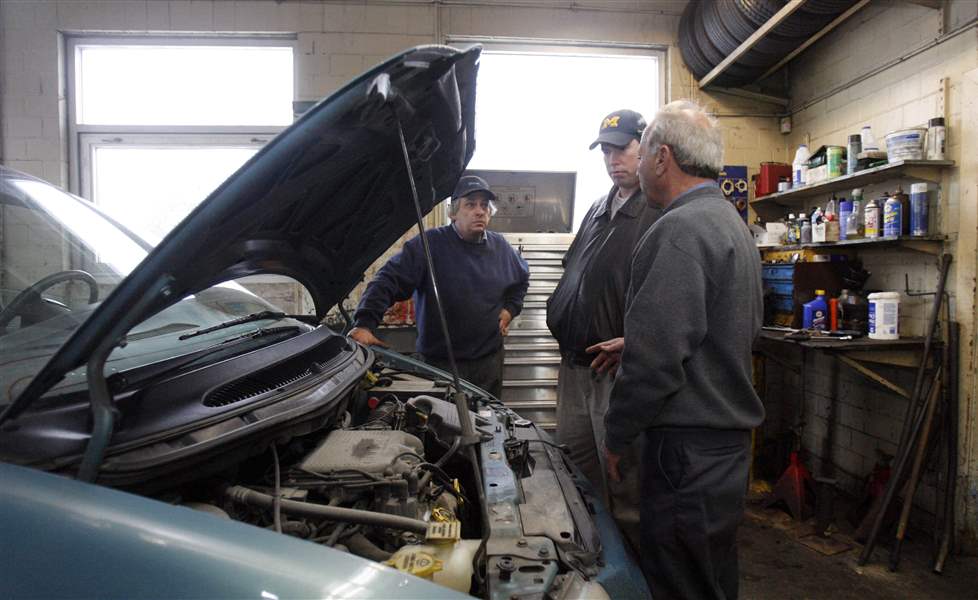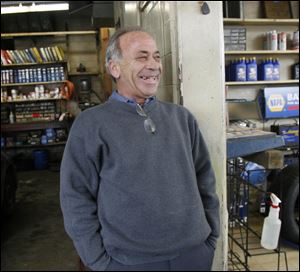
Retro petrol: Customers get traditional service at West Toledo gas station
1/12/2011
Jeff Stang, left, and Michael Canning, right, talk with customer Jeremy Miller about repairs to his van.
The Blade/Amy E. Voigt
Buy This Image
A big luxury car pulls in and drives over a cable that starts a bell clang-clanging and sends Michael Canning out to sweetly ask if the driver wants a fill-up and her oil checked.
Welcome to L & M Sunoco, one of Toledo's last remaining traditional gas stations where grease-stained service manuals sit on a high shelf, chilli nachos are nowhere to be found, and the only M&Ms come at the pull of a lever from a machine.
"If you're looking for a Slushy, bottled water, or beef jerky, I can't help you," says Mr. Canning, who bought the station from his father in 1984. "We just fix cars and pump gas."
Traditional stations such as Mr. Canning's, 2120 Sylvania Ave. in West Toledo, are becoming the stuff of legend, says Jeff Lenard, spokesman for the National Association of Convenience Stores. They are found more often in Hollywood movies -- usually in moody scenes set in the California desert -- than along America's highways and boulevards, he says.

Michael Canning is the owner of L & M Sunoco in West Toledo.
Mr. Lenard isn't sure about how many traditional stations exist, but notes that 80 percent of gasoline in the United States is sold at convenience stores.
"It's a very retro place," concedes the Toledo station's owner, a 1969 graduate of Start High School who hoped to be a news photographer when he was a student at Ohio State University and, later, the University of Toledo. But he lost interest in school and ended up dropping out to do the one thing he planned to avoid: work at the gas station bought by his father, Len, in 1970.
Nestled between Upton Avenue and Douglas Road along Sylvania, the light brown brick building has a Nixon-era appearance.
Inside, the atmosphere is Spartan and characteristic of a time when the key to retail success was linked more to a friendly smile, pleasant word, and satisfactory work than in fancy surroundings.

Jeff Stang, left, and Michael Canning, right, talk with customer Jeremy Miller about repairs to his van.
A slightly rusty, upright drinking fountain does duty near the door. Off-white floor tiles, which have grown more off-white over the years, are broken and missing in sections. Paint peels from the ceiling, near where a gray, dual-blade fan bearing a General Electric logo sits silently.
"It barely works," Mr. Canning says with a slight chuckle. "We use it in the winter to defrost the windows."
A pop machine (50 cents a can) and candy machine (75 cents for a selection that includes Chuckles jelly candy) pump out the establishment's only human fuel.
In adjoining service bays, a pneumatic wrench screeches as a mechanic works under a car high on one of two hoists.
The owner says that young people often walk in, look around disgustedly, and, before fleeing, sniff: "This isn't a real gas station."
"I used to get mad," says Mr. Canning, 59. "But in their world, it isn't a real gas station. We don't sell chips, food, and drinks."
The stark atmosphere doesn't scare away customers like Jeremy Miller, a 34-year-old pizza shop owner.
"I buy every drop of my gas here," says Mr. Miller, who uses the station's self-serve pumps where gas is 25 cents a gallon cheaper than at the full-service pumps.
"I can't stand going into a place where people are buying cigarettes and lottery tickets, paying their cell phone bills and talking on their cell phones and I have to spend 10 minutes in line. I'd rather stop at a place where I can buy my gas and go."
Many drivers, however, make a quick exit when they see the station lacks pay-at-the-pump service, assuming it doesn't accept credit cards. "I tell people we're into physical fitness," the owner says. "You got to walk in and use the credit-card machine."
Over the years, most stations like Mr. Canning's have converted to convenience stores as owners attempted to fatten slim profits from gas sales with higher-profit coffee and sandwiches. Meanwhile, says the convenience store association's Mr. Lenard, car manufacturers encouraged vehicle owners to go to dealers for repairs.
Mr. Canning, who worked as a mechanic at the station before buying it, has no plans to change things.
"Running a grocery store and running a repair shop are two different things," he says. "It's a whole new industry I'm not familiar with. There's a bunch of convenience stores out there."
He estimates that the full-service pumps generate a third of gas sales. Customers travel from distant neighborhoods throughout the metro area for the service.
Still, he sells a fraction of the gas of bigger stations. It's a good day when 100 cars pull up to the pumps, he says. Some stations see that traffic in an hour.
And demand for repair work is inconsistent, especially in years with mild winters. When the leaves begin to fall each year, "cold is good, warm is bad" for business, Mr. Canning says.
As a result, on some days he is sorry he doesn't have more than one full-time mechanic and other days when "we wish we brought in a deck of cards." Still, repair work brings in the biggest share of profits.
As the owner talks, a customer who has pumped $8 in gas drops a $20 bill on the gray metal desk that serves as a counter. Mr. Canning dishes out the change and says: "All right buddy, have a nice day and thank you."
Despite a bit of deferred interior maintenance, the station has a clean rest room unlike those at many traditional stations in earlier times.
And Mr. Canning, who has no plans to retire, makes no apologies for his establishment.
"It hurts in so many places," he says. "It's hot in the summer. It's cold in the winter. That's just the way it is. I'm not interested in buying a TV or cable for my customers. It's an old-time service station."
Contact Gary Pakulski at: gpakulski@theblade.com or 419-724-6082.